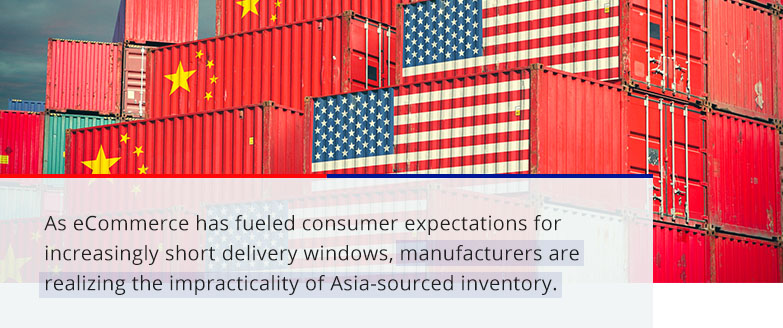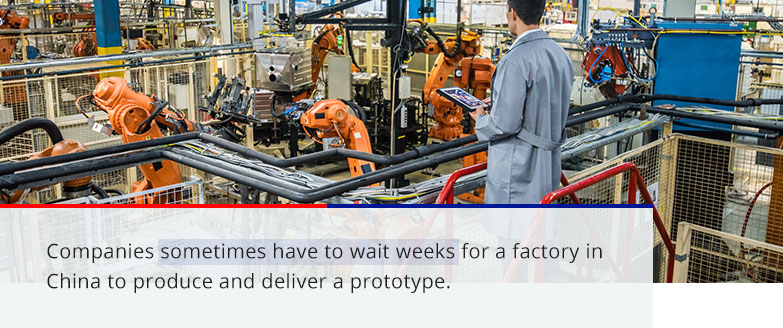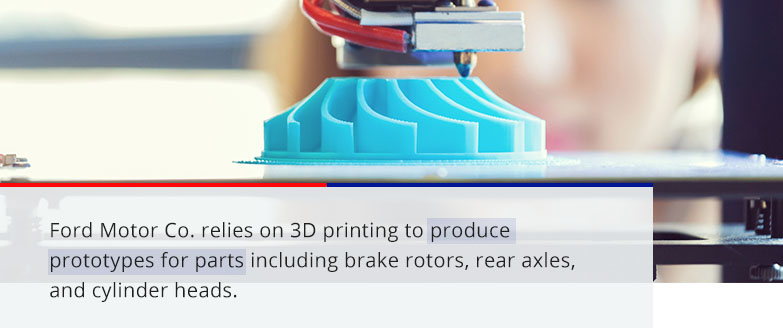Blog
Preparing Your Logistics Strategy for Today’s Advanced Manufacturing Practices

A December 2016 segment on the CBS News program 60 Minutes examined the economic growth taking place in a region of Mississippi known as “the Golden Triangle,” with a specific emphasis on the role one man, economic developer Joe Max Higgins, has played in luring new manufacturers to the community. As the segment made clear, several of those companies were returning manufacturing to the United States after originally locating in Asia.
“For some companies, offshore wasn’t as great as they thought it was or as it was portrayed to be,” Higgins said in the segment. “Many of the companies said, ‘Hey if it’s gonna be consumed in the U.S., we can produce it in the U.S. cheaper and more efficiently than we can elsewhere and bring it in.’” Mr. Higgins’s remarks reflect a nationwide trend, as a growing number of U.S. businesses recognize the viability of either keeping production in the United States in the first place or bringing it back from other overseas locations.
Research by Deloitte on behalf of The Manufacturing Institute found nearly half of U.S. manufacturing companies surveyed would consider reshoring at least part of their operations by 2020. Top reasons for returning operations to the United States include:
- Favorable logistics and supply chains in the United States – 90 percent
- Diminishing cost structure differential – 87 percent
- Increase in domestic demand – 80 percent
This inclination toward reshoring reflects an overall upswing in U.S. manufacturing. U.S. manufacturers produced roughly $6.2 trillion worth of goods during 2015, which amounted to about 36 percent of total U.S. gross domestic product. As MarketWatch reported, that output is nearly double the level of any other leading sector, including professional and business services, government, and real estate.
And, at a time when the Trump Administration has vowed to improve the regulatory and business climate in the United States, many businesses have signaled their plans to expand
U.S. operations. Important to note, the look and feel of today’s manufacturing facilities are vastly different from the labor-intensive, assembly line-based plants that once dominated.
Today’s facilities are increasingly driven by “advanced manufacturing techniques,” including highly sophisticated technology platforms, automated systems, artificial intelligence, and robotics. This means the needs of today’s manufacturing facilities are vastly different. For one thing, greater automation means not as many workers are needed and those who are required must be highly skilled in fields including computer science, engineering, and technology.
The Deloitte research found nearly 80 percent of manufacturers report a serious shortage of qualified applicants for skilled and highly skilled production positions. “Over the next decade,” the report summarized, “nearly three and a half million manufacturing jobs likely need to be filled and the skills gap is expected to result in two million of those jobs going unfilled.”
Beyond a skilled workforce, today’s manufacturers also rely on world-class infrastructure networks so that suppliers’ deliveries can be timed to the minute and finished products easily entered into a distribution network. Manufacturers are increasingly locating their facilities close to vital highway and rail networks, airports, and ports. This highlights the need for strong logistics support.
Today’s manufacturers rely on their logistics provider to enable the fast and highly efficient pickup and delivery capabilities vital to success. And logistics providers are rising to the challenge with innovative, technology-based solutions that ensure seamless service and unprecedented capabilities. From reduced ground transit times to expedited services to international customs expertise, many manufacturers are quick to credit their logistics providers as integral to their success.
The following discussion will focus on the growing trend among manufacturers to locate operations in the United States. Specifically, the discussion will identify key logistics and transportation issues that can help ensure success as well as the importance of having the right logistics provider on your team.
Asia Is Not the Bargain It Once Was
When U.S. manufacturers began outsourcing production to China, management could depend on production costs that were generally 25 to 30 percent lower than in the United States. Companies were attracted by lower labor costs, favorable tax structures, and generous government incentives.
Consider the experience of Apple in outsourcing manufacture of its iPods and iPhones to its Taiwan-based manufacturing partner, Foxconn. When Foxconn needed to build a new manufacturing facility, reporting by the New York Times found, cities across China lined up to offer company executives troves of incentives, including tax benefits, infrastructure improvements, and employee housing.
Municipal leaders in Zhengzhou, which ultimately won the bidding process, reportedly “doled out more than $1.5 billion to Foxconn to build large sections of the factory and nearby employee housing. It paved roads and built power plants. It helps cover continuing energy and transportation costs for the operation. It recruits workers for the assembly line. It pays bonuses to the factory for meeting export targets,” the Times reported.
The government also spent more than $10 billion to expand its airport and created a “bonded zone,” which is essentially an area considered to be foreign soil where finished products benefit from facilitated import and export rules. As the Times’s report notes, while many American officials decry this level of government support, calling the subsidies and other aid “an unfair competitive advantage in a global marketplace,” there is no denying the arrangement has been a success. Analysis by Industry Week noted, “both the products and the process have been roaring successes, making Apple
the most valuable company in the world.”
Recently though, economic and political changes in China may be causing some U.S. manufacturers to think twice about entering into similar arrangements. As Industry Week reported:
- Wages in China are rising.
- Increased automation of manufacturing processes is expected to decrease labor production costs, as fewer workers are needed. This could further diminish China’s appeal as a source of low-cost labor.
- China’s growing tendency to be an “unpredictable partner” makes U.S. businesses feel unsettled by China’s recent actions to block Apple’s iBooks and iTunes movies online stores, and by the removal of the New York Times app from the Apple store.
Beyond these trends, the New York Times cited developments that may be causing U.S. manufacturers to reconsider investing in Chinese operations:
- The government has announced an initiative to build its own technology industry and is pressuring local governments to cut the generous subsidies that have encouraged U.S. investment.
- This rising demand in China for domestic production may cause Chinese suppliers to shift their focus away from the needs of U.S. exporters.
- U.S. exporters, “courted and protected for decades by Beijing,” have come under increased scrutiny.
These developments are in addition to less than favorable experiences U.S. manufacturers encountered when production was moved out of the United States:
Untenable shipping times. As eCommerce has fueled consumer expectations for increasingly short delivery windows, manufacturers are realizing the impracticality of Asia-sourced inventory. In an interview with PBS, the president of an Alabama-based fan blade manufacturer noted the role delivery times had in his company’s decision to return manufacturing back to the U.S.: “By shipping products from China, ‘you’re adding weeks, and it’s hard to time. The variability of a container can take three weeks or it can take six months.’” In another example, General Microcircuits Inc. (GMI) experienced “regular” transit times of 35 to 45 days for shipments between its Asian partners and the U.S. The company was able to reduce average transit time to seven days, or four hours by air, by moving production nearer to home in Costa Rica.
Social Issues. Poor working conditions in some Asian factories have caused a backlash against low-cost goods manufactured in “sweatshop conditions.”
Time Zones. Severe time zone discrepancies stymied communication between U.S.-based manufacturers and their Asian production facilities.
Quality Control. Many manufacturers reported difficulty in monitoring quality and protecting company intellectual property and assets. As reported by MHI, one U.S.-based manager went to visit an Asian plant where his company had outsourced manufacturing and found two identical production lines operating – “one for his company’s product and one for the manufacturing partner to sell on its own.”
Positive U.S. Developments Foster Domestic Investment
At the same time, a number of positive developments in the U.S. are facilitating the decision by many businesses in favor of domestic production:
- Lower energy costs. As reported in Fortune, research by the Boston Consulting Group found American competitiveness has been profoundly impacted by lower energy costs, specifically by fracking, which has “dramatically driven down the price of oil and gas that’s being used in energy-intensive industries such as steel, aluminum, paper, and petrochemicals.” Energy prices have fallen so dramatically that the consulting firm estimates China now holds just a 5 percent advantage in
manufacturing costs. BCG projects that by 2018, it will be 2 to 3 percent less expensive to manufacture goods in the United States.
“A 5 percent discrepancy in manufacturing between China and the U.S. doesn’t amount to much,” BCG analyst David Gee said, “when you consider that U.S. manufacturers face the risks of delay when shipping from China, the threat of port strikes, and the local investments and partnerships that Beijing often requires of foreign companies doing business there.”
- Reduced inventory costs. U.S. – or North American – based production alleviates the need for manufacturers to store disproportionately large amounts of inventory to meet consumer demands for fast delivery. The trend in recent years had been for manufacturers to stock up so as to avoid unforeseen delays in moving inventory from Asia. Sourcing production closer to end customers allows manufacturers to reduce inventory carrying costs dramatically. And, as Forbes pointed out, excess inventory is both costly and risky, as stored inventory runs the risk of damage, theft, loss, and, in the case of technology or fashion, obsolescence.
- Potentially favorable business and regulatory environment. The Trump administration has promised to lower corporate taxes and reduce the regulatory burden that many businesses say has impeded their ability to operate in the U.S. According to the National Association of Manufacturers (NAM), at the end of 2016 manufacturers faced almost 300,000 regulatory restrictions, with 87
percent of manufacturers saying they would invest in hiring, increased salaries and wages, and research and development, if the regulatory burden was eased. At the end of 2016, manufacturers faced almost 300,000 regulatory restrictions - Seamless continuity between research and manufacturing. Many companies with overseas manufacturing quickly realized the inefficiency of having an ocean in between their engineering/development teams and their production facility. Forbes quoted one Silicon Valley executive as saying: “At any given moment in time, there is probably the equivalent of one Boeing 747 full of our engineers flying back and forth between the U.S. and China, just to facilitate the dialogue between development and manufacturing.” Forbes also notes that many Chinese facilities suffer high worker attrition rates, meaning there is no institutional knowledge that can be passed down about a particular U.S. company’s production process.
In addition, companies sometimes have to wait weeks for a factory in China to produce and deliver a prototype. As a result, companies are realizing the benefit of having their manufacturing and development functions – if not in the same zip code – at least in the same hemisphere.
U.S. Manufacturing Today – Advanced, Automated, and Productive
Three critical points to recognize before beginning any discussion about current U.S. manufacturing trends:
- Although larger corporations tend to garner most of the headlines, the vast majority of U.S. manufacturers are small- to medium-sized businesses. The National Association of Manufacturers reports that of the 252,000 manufacturing firms in the U.S., all but 3,750 are considered “smaller,” meaning they have fewer than 500 employees. In fact, NAM notes, “three-quarters of these firms have fewer than 20 employees.”
- Today’s manufacturers are experiencing what PriceWaterhouse Coopers (PwC) refers to as a “technological renaissance” – that is, transforming the look, systems, and processes of the modern factory. Manufacturers have little choice but to embrace these changes, or they’ll lose ground to rivals that are making the necessary adjustments.
- Manufacturers face increased pressure from customers for increasingly short lead times for products delivered consistently on time, undamaged, and up to specifications. It’s not surprising then that today’s manufacturing facilities have a dramatically different look and feel from their predecessors. The PwC analysis identified four technology-based trends driving much of the change afoot in today’s manufacturing facilities.
Internet of Things (IoT). Forbes defines the “Internet of Things” as “the concept of basically connecting any device with an on and off switch to the Internet (and/or to each other).” Thus the IoT can be as simple as connecting a kitchen coffee maker to a smartphone alarm clock, or as complicated as connecting jet engine components. Forbes cited research by Gartner, which estimates 26 billion connected devices by 2020. And in separate research, PwC estimated manufacturers will realize as much as $4 trillion in value from the IoT, mainly through increased revenue and lower costs. It’s easy to see then the role of the IoT in today’s factories where all manufacturing processes – machines, sensors, computers, and humans – can be linked and fully integrated.
“These devices provide more precision and can translate collected data into insights that, for example, help determine the amount of voltage used to produce a product or to better understand how temperature, pressure, and humidity impact performance,” the PwC analysis noted. Adding this level of sophistication will be difficult for some manufacturers, especially those with older equipment.
Mechanical engineering Professor David Dornfield, of the University of California, Berkeley, told PwC, “One problem is that a lot of plants and machines are purpose-built, and so linking all systems together in a way to gather data and make it useful can in some cases be trying.” Older machines need to be retrofitted, adding time and expense, Professor Dornfield noted. “But once you get the data and analyze it, you start to understand the DNA of your equipment – and assign, for example, a likely cause for a problem when you see a deviation in performance – whether it be that a tool is
wearing out, or even a connection between the temperature of the plant and problems with certain processes. One can more accurately anticipate issues and can fix them before they cause a real problem,” he added.
Robotics. Ready or not, industrial robots are on the job in production facilities around the globe, with almost 60 percent of manufacturers surveyed telling PwC they currently use some sort of robotics technology. As technology has developed, robots have taken on increasingly “human” characteristics such as, PwC notes, sensing, dexterity, memory, trainability, and object recognition. “As a result, they’re taking on more jobs – such as picking and packaging, testing or inspecting products, or assembling minute electronics.”
One big advantage of robots is their role in helping manufacturers locate production closer to their customers. This is because robots can be programmed to perform certain manufacturing-related tasks previously conducted in overseas facilities. As an example, PwC cited a Hong Kongbased footwear maker that opened a facility in Tennessee to be closer to its end customers. The manufacturer relied on a robot to “roughen” leather before gluing it to soles – a process that could just as easily be done in Tennessee as in China. “It costs the same to buy the same robot in China or the U.S., so for U.S. companies selling to the U.S. market, customizing to consumers’ choice or preferences is a solid reason to bring manufacturing back to the U.S.,” Scott Paul, president of the Alliance for American Manufacturing, told PwC.
The research notes, however, that U.S. manufacturers are less inclined to favor “full automation” of their facilities and instead seek a hybrid approach known as “cobotics.” The cobotics approach allows human operators to “team” with a robotic machine to make complex parts faster, easier, and safer.
Additive Manufacturing (AM)/3-D Printing. According to TMR Research, additive manufacturing refers to “the concept of creating 3D objects that are solid, and can be of any size or shape to suit the requirement of the engineered products.” Although still in its formative years, 3D printing is widely expected to evolve into a mainstay of U.S. manufacturing. In the aerospace industry alone, 3-D printing is being used to make prototypes and parts at lower costs, and to create designs not possible via traditional manufacturing.
Ford Motor Co., as reported by PwC, relies on 3D printing to produce prototypes for parts including brake rotors, rear axles, and cylinder heads. The process allows the company to skip a few steps in the design process, saving up to two months. But General Electric proved to be a 3-D innovator in 2016 by using the technology to create the fuel nozzles – the actual parts – for its new LEAP family of engines.
PwC research found 66.7 percent of manufacturers are adopting 3D printing in some way:
- Experimenting to determine how we might apply – 28.9 percent
- Prototyping only – 24.6 percent
- Prototyping and production – 9.6 percent
- Building products that cannot be made from traditional methods – 2.6 percent
- Production of final products/components only – 0.9 percent
At this point in its development, 3D printing remains prohibitively costly for many companies. And as José Zayas, director of the U.S. Department of Energy’s Wind Energy Technologies Office (WETO), noted in a recent article, the process is not right for everyone. “3D printing is best used for highly complex components, such as those comprising several pieces, which can be 3D printed as
a single item, or where extra functionality, and therefore value, can be added,” he explained. “If you have a product that can be easily made by traditional manufacture, then AM is not right. You need to find enough value to put in the components to balance the high cost,” Zayas added.
But make no mistake, additive manufacturing is here to stay, especially as costs begin to decrease. Scott Paul of the Alliance for American Manufacturing believes additive manufacturing will be “key” to the future of small manufacturers. “As we see the possibilities of new materials expand and the cost of industrial printers go down, and the print speeds rise, you’ll see adoption not only by larger companies, but also by the smaller companies,” he told PwC researchers.
Augmented Reality. Time magazine reports that augmented – and virtual – reality will soon “unlock completely unpredictable new ways of being productive with a computer.” Whereas computer users have “grown up” using interfaces including keyboards, a mouse, their finger, and more recently their voice, augmented reality is the “next big thing.” As PwC explains, “Users simply follow the text, graphics, audio, and other virtual enhancements superimposed onto goggles or real assemblies as they perform complex tasks on the factory floor. These tools can simultaneously assess the accuracy and timing of these tasks, and notify the operator of quality risks.”
Some manufacturers are using the new technology to provide hands-free training, enable faster responses to maintenance requests, track inventory, increase safety, and provide a real-time view of manufacturing operations. The implications are seemingly limitless, with some predicting elimination of fatigue-caused mistakes and the ability to use data retrieved from augmented reality devices to design better manufacturing processes.
Clearly then, innovation has taken America’s manufacturing facilities by storm and enabled much of the efficiency and productivity we see today. In fact, as MarketWatch reports, today’s U.S. factories produce twice as much as they did 30 years ago but with one-third fewer workers.
Refine Your Logistics Strategy Today with Purolator International
As innovation becomes an even greater part of modern manufacturing, businesses need to strive for innovation within their logistics strategy, as well.
At Purolator International, we work with a number of different industries to develop custom, efficient supply chain solutions. If you’re looking to improve your supply chain operations in an effort to modernize your logistics strategy, contact Purolator International today.



